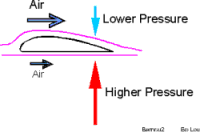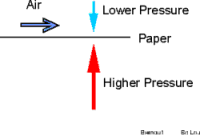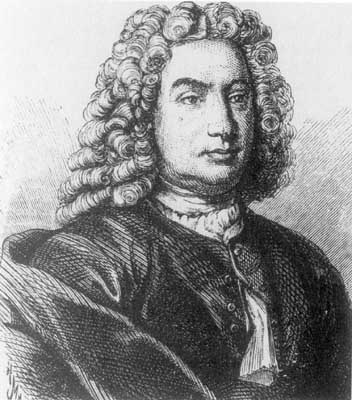 |
 |
 |
 |
 |
 |
 |
 |
 |
|
|
|
|
|
|
|
|
|
|
|
|
|
|
|
|
Bernoulli's
Principle states that a fluid in motion has a lower pressure than the same
fluid not in motion. Similarly, the higher the velocity of the fluid, the
lower the pressure. The most common example of this principle can be seen
in the airplane wing (see figure below). |
|
|
|
|
|
|
|
|
|
|
As
you can see, the air above the curved wing must travel a greater distance
in order to arrive at the end of the wing at the same time as the air below
the wing. Accordingly, the air above the wing has a greater velocity. Since
Bernoulli's principle states that a fluid at higher speed has a lower pressure,
the faster air above the wing has a lower pressure, and pulls the wing
up, along with the aircraft attached to it. (O'Connor, 2001) |
|
|
|
|
|
 |
|
|
|
|
|
|
|
|
This
can principle can be easily demonstrated by holding a small strip of paper
up to your lower lip and blowing across the top of the paper. If done correctly,
the paper will rise upward due to the lower pressure. The same
effect acts on the paper as on an airplane wing (see figure at right) |
|
|
|
|
|
|
|
 |
|
|
|
|
|
|
|
|
|
Daniel
Bernoulli: A Brief Biography |
|
|
|
|
|
|
|
|
|
Daniel
Bernoulli was born on the eighth of February in 1700 in Groningen, The
Netherlands to a prestigious family of mathematicians. His father
was Johann Bernoulli, his brothers were Nicolaus and Jacob (II) Bernoulli,
and his uncle was Jacob Bernoulli, all of which were well-known European
mathematicians of the 18th century (Quinney, 2001). His most important achievement
was his work on the properties of fluids, though he is also known for several
other works. In 1725, Daniel and Nicolaus were invited to the St.
Petersburg Academy of Sciences, where Daniel collaborated with Leonhard
Euler beginning in 1727. In 1731 (and later in 1759), he performed
research on the mathematics of life insurance and health statistics.
He went to Basel, Switzerland in 1733, and remained there for the rest
of his life, teaching anatomy, botany, physiology, and physics. His
most famous work, Hydrodynamica, was completed in 1737.
It explored the properties of fluid flow, pressure, density, and velocity.
Daniel Bernoulli died on March 17th, 1782 in Basel (Lee, 2001). |
|
|
|
|
|
|
|
 |
|
|
|
|
|
|
|
|
|
|
Lee,
Moon J. "Daniel Bernoulli." The MacTutor History of Mathematics
Archive. 9 May 2001
<http://mech.postech.ac.kr/fluidmech/history/Bernoulli.html>
O'Connor, J.J., and E.F.
Robertson. "Daniel Bernoulli." School of Mathematics and Statistics, University
of St. Andrews. 8 May 2001
<http://www-groups.dcs.st-andrews.ac.uk/~history/Mathematicians/Bernoulli_Daniel.html>.
Quinney, Dr. D.A. "Daniel
Bernoulli and the making of the fluid equation" The Turner Collection,
Keele University. 9 May 2001
<http://plus.maths.org/issue1/bern/tindex.html>
Home
|
|
|
|
|


